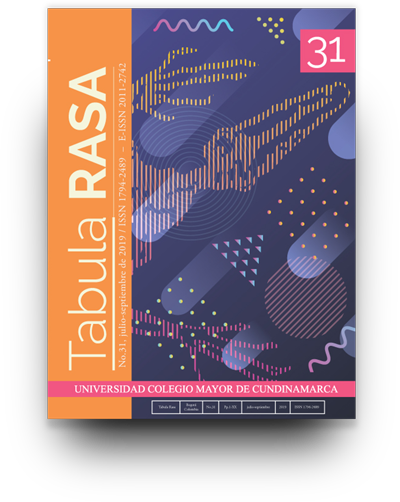Dead body and materiality : theoretical-conceptual inquiries.
Cuerpo muerto y materialidad : exploraciones teóricas-conceptuales.
Show authors biography
This paper inquires for the potential and limitations of structuralist-based (Mary Douglas and Julia Kristeva) and phenomenological (embodiment theories) theoretical proposals to think of the body in general, and of dead body in particular. ftroughout the text, I aim to account for the complexity of the (socially crafted) distinction between the living and the dead, and to show in which dimensions it is suitable to think of identity beyond the threshold of death. Additionally, several theoretical guidelines are outlined to build conceptual alternatives for its analysis, based on the feminist criticism on notions of gender, sex, matter, and nature.
Article visits 188 | PDF visits 90
Downloads
- Baglow, J. S. (2007). fte rights of the corpse. Mortality, 12(3), 223-239.
- Barley, N. (2000). Bailando sobre la tumba: encuentros con la muerte. Barcelona: Anagrama.
- Bartlett, E. T. (1995). Differences Between Death and Dying. Journal of Medical Ethics, 21(5), 270-276.
- Bleyen, J. (2010). fte materialities of absence after stillbirth: Historical perspectives. En Hockey, J. L., Komaromy, C. & Woodthorpe, K. (comps.), The matter of death: space, place and materiality, (pp. 69-84). New York: Palgrave Macmillan.
- Bordelois, I. (2009). A la escucha del cuerpo: puentes entre la salud y las palabras. Buenos Aires: Libros del Zorzal.
- Brante, T. & Hallberg, M. (1991). Brain or heart? fte controversy over the concept of death. Social Studies of Science, 21(3), 389-413.
- Butler, J. (2008). Cuerpos que importan: sobre los límites materiales y discursivos del «sexo». Buenos Aires: Paidós.
- Butler, J. (2007). El género en disputa: el feminismo y la subversión de la identidad. Barcelona: Paidós.
- Csordas, T. J. (1990). Embodiment as a Paradigm for Anthropology. Ethos, 18(1), 5–47.
- De Baets, A. (2004). A Declaration of the Responsibilities of Present Generations Toward Past Generations. History and Theory, 43(4), 130–164.
- Douglas, M. (1996). Natural symbols: explorations in cosmology. London: Routledge.
- Douglas, M. (1973). Pureza y peligro: un análisis de los conceptos de contaminación y tabú. Madrid: Siglo XXI.
- Foucault, M. (2008). El nacimiento de la clínica: una arqueología de la mirada médica. Buenos Aires: Siglo XXI.
- Hallam, E, Hockey, J. & Howarth, G. (1999). Beyond the body: death and social identity. London: Routledge.
- Haraway, D. (1995). «Género» para un diccionario marxista: la política sexual de una palabra. En Ciencia, cyborgs y mujeres: la reinvención de la naturaleza, (pp. 213-250). Madrid: Cátedra.
- Hirschauer, S. (2006). Animated Corpses: Communicating with Post Mortals in an Anatomical Exhibition. Body & Society, 12(4), 25-52.
- Hockey, J., Komaromy, C. & Woodthorpe, K. (2010). The matter of death: space, place and materiality. New York: Palgrave Macmillan.
- Kaufman, S. & Morgan, L. (2005). fte Anthropology of the Beginnings and Ends of Life. Annual Review of Anthropology, 34(1), 317-341.
- Kristeva, J. (1988). Poderes de la perversión: ensayo sobre Louis-Ferdinand Céline. México: Siglo XXI.
- Latour, B. (2012). Cogitamus: seis cartas sobre las humanidades científicas. Buenos Aires: Paidós.
- Lévi-Strauss, C. (2006). Tristes trópicos. Barcelona: Paidós. Lévi-Strauss, C. (1999). Raza e historia. Barcelona: Altaya.
- Lévi-Strauss, C. (1973). El desdoblamiento de la representación en el arte de Asia y América. En Antropología estructural, (pp. 221-242). Buenos Aires: Eudeba.
- Lock, M. (2009). Death in technological time: locating the end of meaningful life. Medical Anthropology Quarterly, 10(4), 575-600.
- Lock, M. (2004). Living cadavers and the calculation of death. Body & Society, 10(2-3), 135-152.
- Lock, M. (2002). Twice dead: organ transplants and the reinvention of death. Berkeley: University of California Press.
- Renteln, A. (2001). fte Rights of the Dead: Autopsies and Corpse Mismanagement in Multicultural Societies. South Atlantic Quarterly, 100(4), 1005-1027.
- Rosenblatt, A. (2010). International Forensic Investigations and the Human Rights of the Dead. Human Rights Quarterly, 32(4), 921-950.
- Rubin, G. (1998). El tráfico de mujeres: notas sobre la «economía política» del sexo. En Navarro, M. & Stimpson, C. (comps.). ¿Qué son los estudios de mujeres? México: Fondo de Cultura Económica.
- Shilling, C. (1993). The Body and Social Theory. Theory, Culture & Society. London: Sage Publications.
- Sudnow, D. (1971). La organización social de la muerte. Buenos Aires: Tiempo contemporáneo.
- Walter, T. (2004). Plastination for display: a new way to dispose of the dead. Journal of the Royal Anthropological Institute, 10(3), 603-627.




